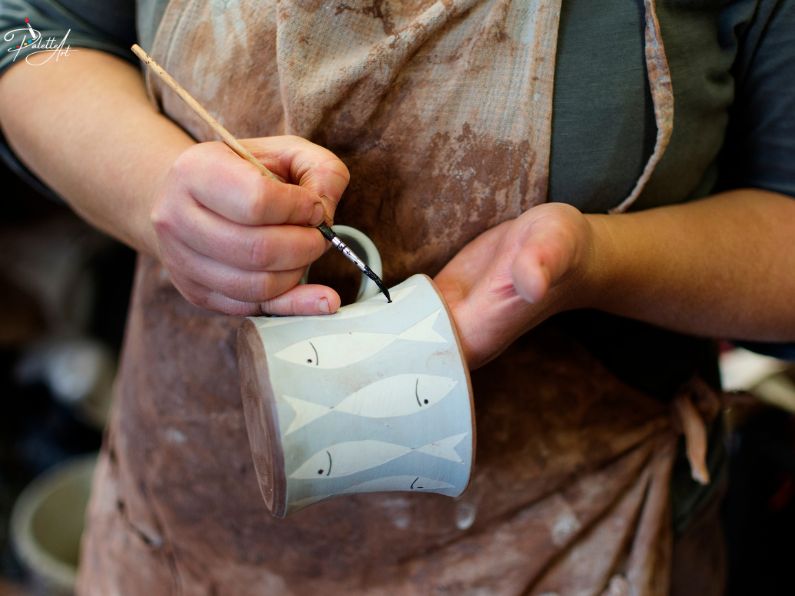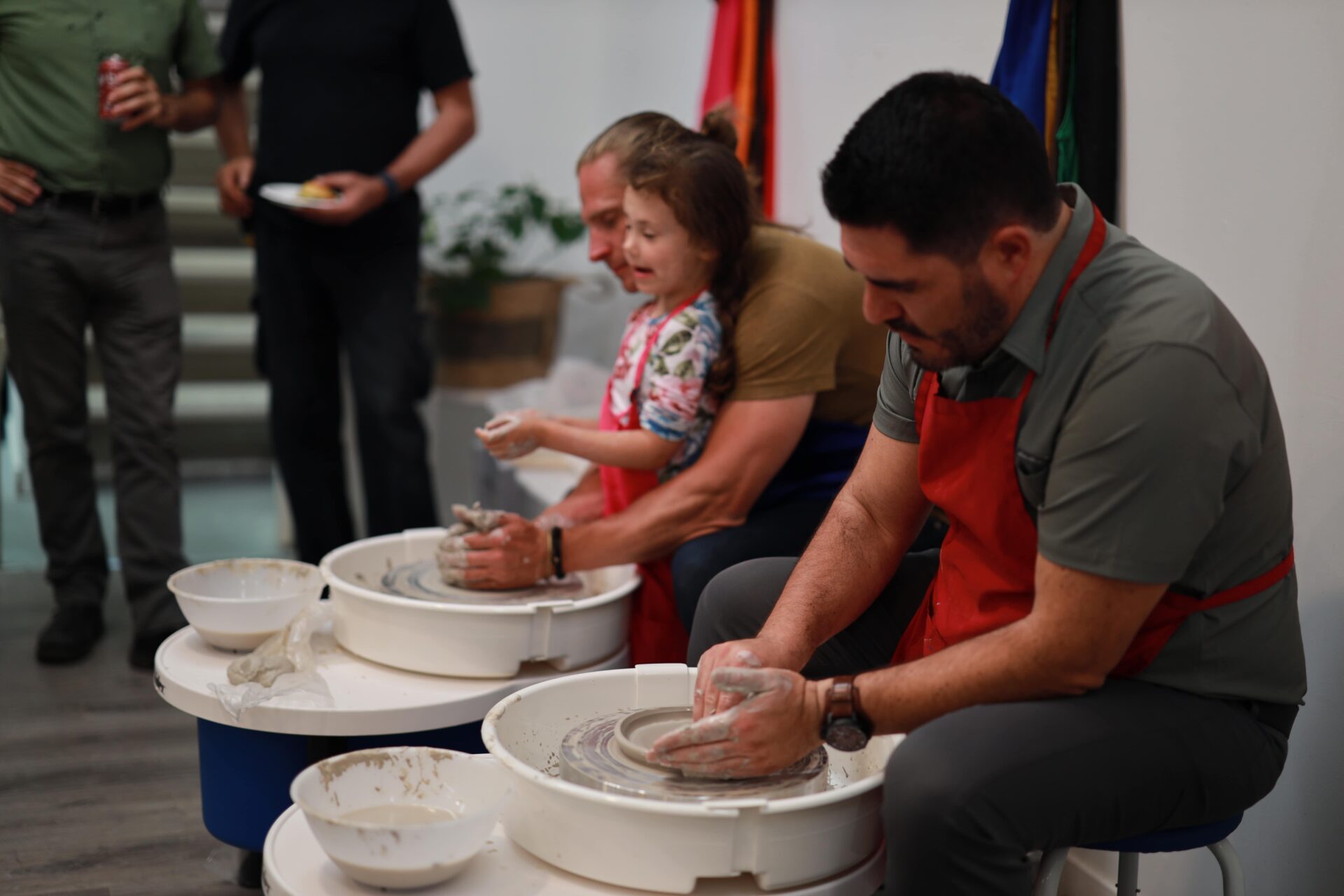What is Marbled Pottery? Marbled pottery is a unique and visually captivating style where different colors of clay or glaze are swirled together to create a marbled effect. This technique brings an artistic flair to ceramic pieces, making each one a distinct work of art.
History of Marbling in Pottery Marbling techniques have a rich history, dating back to ancient civilizations. The Japanese have a traditional method called Nerikomi, while the Italians developed Scagliola, both demonstrating the diverse approaches to marbled pottery across cultures.
Contents
Understanding Marbled Effects in Pottery Painting
Types of Marbling Techniques
- Slip Marbling: This involves using colored slips (liquid clay) applied to the surface of a piece to create intricate patterns.
- Agateware Technique: Combining different colored clays to create a striated, marble-like effect.
- Marbling with Underglazes: Using underglazes to achieve a marbled look by painting or swirling colors on the pottery surface.
Materials Needed for Marbling
- Various clays (white, colored)
- Colored slips
- Underglazes
- Brushes, sponges, and other application tools
- Pottery wheel (optional)
- Sealants and glazes

Preparing Your Pottery
Choosing the Right Clay Selecting the appropriate clay is crucial. Stoneware or porcelain clay bodies are commonly used due to their smooth texture and ability to showcase marbling patterns beautifully.
Preparing the Surface The surface of the clay should be smooth and free of debris. Wedge the clay to remove air bubbles and ensure a consistent texture before beginning the marbling process.
Basic Marbling Techniques
Slip Marbling Apply colored slips to the leather-hard clay surface. Use brushes or pour the slips directly onto the clay, then manipulate the colors to create swirling patterns.
Agateware Technique Layer different colored clays and wedge them together to create a striated pattern. This method can be used to form slabs or thrown on a wheel to create varied marbling effects.
Marbling with Underglazes Paint underglazes onto the clay surface in desired patterns. Use tools like combs or fingers to swirl and blend the colors, creating intricate designs.
Advanced Marbling Techniques
Japanese Nerikomi Nerikomi involves layering colored clay to create patterns that are revealed when slices are cut from the block. This technique requires precision and patience.
Italian Scagliola Scagliola mimics the appearance of marble and involves mixing gypsum, pigments, and glue. While traditionally used for architectural elements, it can be adapted for pottery.
Step-by-Step Marbling Marbled Effects in Pottery Painting Process
Mixing Colors for Marbling Combine different colored slips or underglazes. Test small batches to understand how colors interact and blend.
Creating Marbled Slabs Roll out slabs of clay and layer colored slips or clay. Roll or press to achieve desired thickness and pattern.
Applying the Marbled Design Transfer marbled slabs onto pottery forms or directly manipulate the clay body to integrate the marbling.
Finishing Touches Smooth the surface and refine the design as needed. Allow the piece to dry slowly to prevent cracking.
Tips for Perfect Marblin
Avoiding Common Mistakes
- Ensure consistent clay moisture to prevent cracking.
- Avoid overworking the clay, which can muddle the marbling patterns.
Experimenting with Colors Try different color combinations and techniques to discover unique effects. Document your process for future reference.
Caring for Marbled Pottery
Marbled Effects in Pottery Painting can create stunning and unique designs, but it’s essential to care for these pieces properly to maintain their beauty. Sealing and glazing are crucial steps in this process; applying a clear glaze not only protects the marbled design but also enhances its visual appeal. For functional pieces, consider using a food-safe glaze to ensure safety and durability. When it comes to cleaning and maintenance, it’s best to use mild soap and water. Avoid abrasive cleaners, as they can damage the glaze and diminish the intricate marbled effects. By following these steps, you can preserve the elegance and functionality of your marbled pottery.
Sealing and Glazing Apply a clear glaze to protect and enhance the marbled design. Consider using a food-safe glaze for functional pieces.
Cleaning and Maintenance Clean marbled pottery with mild soap and water. Avoid abrasive cleaners that can damage the glaze.
Marbled Pottery Ideas
Functional Pieces Create marbled mugs, bowls, and plates that add a touch of artistry to everyday items.
Decorative Pieces Design vases, sculptures, and decorative tiles that showcase the beauty of marbled pottery.
At Pelt Art Studio, we offer a variety of engaging pottery classes tailored for all age groups. Whether you’re looking for a creative outlet for your little ones or a relaxing hobby for yourself, our pottery class for children and pottery class for adults provide the perfect environment to explore your artistic side. Beyond structured classes, our studio is open for anyone who wants to drop in and paint pottery, offering a delightful way to spend time with family and friends. Come and join us for some fun hours, unleash your creativity, and make lasting memories at Pelt Art Studio.

FAQs
What type of clay works best for marbling? Stoneware and porcelain are excellent choices due to their smooth texture and ability to showcase marbling patterns well.
Can I use marbling techniques on any pottery? Yes, marbling techniques can be applied to various pottery forms, including wheel-thrown and hand-built pieces.
How do I fix mistakes in marbling? If the marbling pattern doesn’t turn out as desired, you can rework the clay or apply additional layers of slips or underglazes to modify the design.
What are the best colors for marbling? Bright, contrasting colors often yield striking results. Experiment with different combinations to see what works best for your style.
How do I make the marbled pattern stand out? Use a clear glaze to enhance and protect the marbled design, ensuring the colors remain vibrant and defined.
Do I need special tools for marbling? Basic pottery tools like brushes, sponges, and carving tools are typically sufficient. Specialized tools can help achieve more intricate patterns.
For more information on pottery techniques, check out this comprehensive guide on ceramic art.


